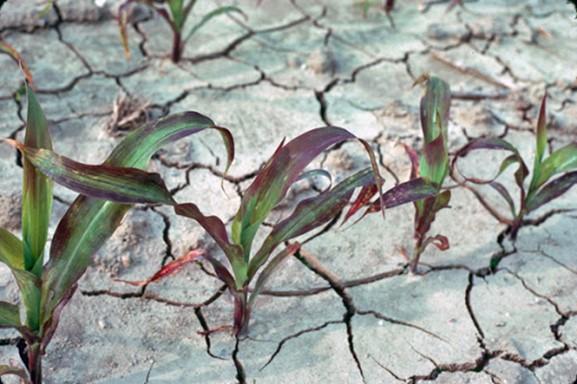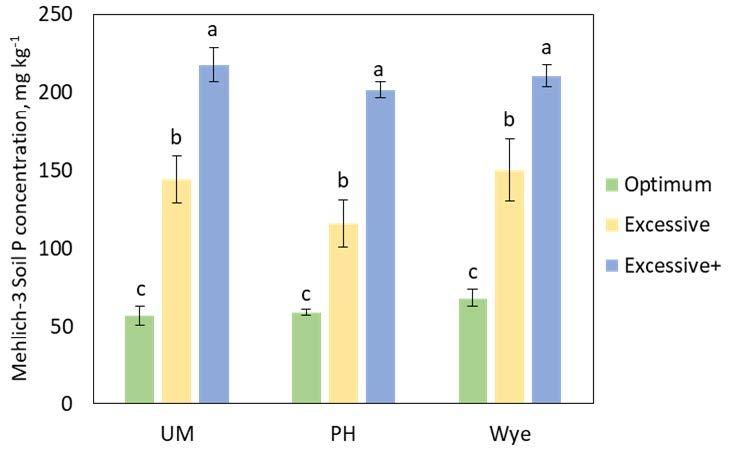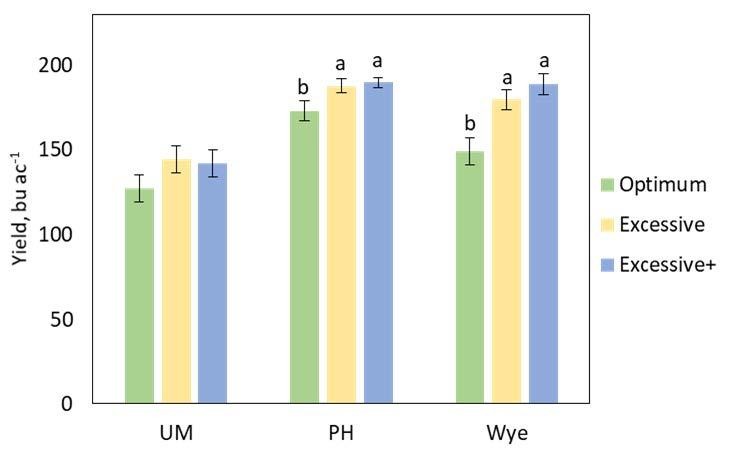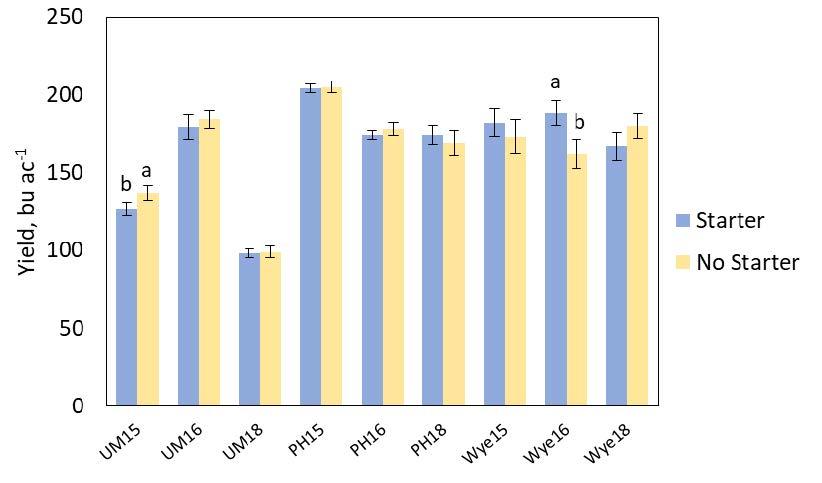
FS-1160 | July 2021
Is Starter Phosphorus Fertilizer Necessary for Corn Grown on Atlantic Coastal Plain Soils?
Isolated areas of Maryland have soil phosphorus (P) concentrations well above what is necessary for crop production. These elevated soil P concentrations are due to historic high, nitrogen-based application rates of poultry litter to agriculture fields without additional chemical fertilizer. Due to the high amount of P in poultry litter, excess P was applied and over time, soil P concentrations increased nearly to saturation in some areas of the state, including Southern MD and the Eastern Shore, which are considered Coastal Plains soils. These application rates were not thought to be excessive at the time, and were, in fact, recommended by Extension advisors, based on the longstanding belief that P did not readily move from the soil. It was not until the 1980’s and 1990’s when researchers learned more about P behavior in soils and research demonstrated increased risk of P loss to surface water where soil P concentrations were high.
The research presented here stems from development of current Phosphorus Management Tool (PMT) regulations in Maryland, where producers with fields containing high soil P concentrations and associated high risk of P loss to surface waters are unable to apply additional P as fertilizer to minimize potential P loss in those fields.
Phosphorus Deficiency in Corn Observed by Producers

Despite having very high soil P concentrations, some Maryland producers observed visual symptoms of P deficiency, including purple plant tissue or early, stunted plant growth (Figure 1). While most growers assumed a solution was to add P fertilizer as starter, other factors likely cause these symptoms. Cold soil temperatures early in the season can impede corn root ability to extract P from the soil. Soil pH outside of the optimum range for crop growth (5.5-6.5) could decrease plant availability of P in the soil. The immediate reaction to add P fertilizer does not account for the P already in the soil that the crop is not able to utilize due to these factors. Therefore, in soils with high P concentrations, it is likely the early season availability of P is limiting crop uptake, not the concentration of P in the soil. If this is the case, the question is whether early season deficiencies will reduce the final yield when a field is considered to have optimum or excessive soil P concentrations.
Research Shows Application of P Fertilizer May Not Increase Yields
Research across the country has demonstrated a corn yield increase with starter fertilizer applications to soils with low P concentrations (McGrath and Binford, 2012; Wortmann et al., 2006). Generally though, when studies were performed on soils with optimum soil P concentrations, no consistent yield response to starter fertilizers was observed (Bermudez and Mallarino, 2002; Cahill et al., 2008; Wortmann et al. 2006). These studies reported early corn growth response to starter fertilizer application on soils with P concentrations near agronomic optimum. This early growth response, however, did not translate to a yield increase (Bermudez and Mallarino, 2002; Bundy and Andraski, 1999; Gordon et al., 1997, 1998; McGrath and Binford, 2012; Roth et al., 2005; Wortmann et al., 2006). Applying starter fertilizer in U.S. southern regions did not result in a yield increase in years with optimal growing conditions (Mascagni et al., 1996). Therefore, it remains difficult to predict when growers might observe a yield response to starter P fertilizer without the ability to predict future growing conditions.
UMD Study Focused on Corn Grown Across Range of Soil P Concentrations
In 2015, we set out to investigate the impact of starter P fertilizer application on corn yield across a wide range of soil P concentrations in Maryland. We did not anticipate starter P application would increase corn yield; however, if it were to impact yield, we hypothesized the impact to be greater at lower soil P concentrations.
We utilized replicated, small plots with a range of soil P concentrations at three University of Maryland Research and Education Centers (REC) across Maryland: Poplar Hill REC, Upper Marlboro REC, Wye REC. Details on the establishment of these plots can be found in Kratochvil et al. (2006) and Fiorellino et al. (2017). We collected soil samples at the beginning of the study in spring 2015 to group plots into one of three soil P categories. Soils were extracted with Mehlich-3 (Mehlich, 1984) extraction to measure P concentration (M3P). Each plot was split in half, with one half receiving a starter fertilizer blend containing P, and the other half receiving starter fertilizer without P. Starter was applied as a liquid, either dribbled on the surface or banded (at the Wye location). Table 1 shows the amount and type of fertilizer applied to plots each year. On these plots, we grew corn in 2015, 2016, and 2018 and collected yield data at the end of each season. In 2015, early season corn growth was visually observed at one location.
| Year | Upper Marlboro (UM) | Poplar Hill (PH)ᵃ | Wye | |||
|---|---|---|---|---|---|---|
| Starter-P | No Starter-P | Starter-P | No Starter-P | Starter-P | No Starter-P | |
| ----------------------------------------------------------------- lbs/acre-¹ ------------------------------------------------------------------- | ||||||
| 2015 | 196-40-0 | 196-0-0 | 157-29-118ᵇ | 145-0-111ᵇ | 139-22-0 | 139-0-0 |
| 2016 | 150-40-0 | 148-0-0 | 168-29-101ᶜ | 157-0-94ᶜ | 159-22-0 | 159-0-0 |
| 2018 | 151-38-0 | 151-0-0 | 196-12-130 | 159-0-130 | 182-22-0 | 180-0-2 |
- ¹ UM – Upper Marlboro REC; PH – Lower Eastern Shore REC, Poplar Hill; Wye – Wye REC
- ᵃ PH applied N,P,K,S,B at pre-plant and applied some N and K with P application at planting.
- ᵇ PH applied 20.5(S)-1.2(B) lbs/acre-1 in this year.
- ᶜ PH applied 19.6(S)-1(B) lbs/acre-1 in this year.
We grouped plots into one of three soil P categories (Figure 2):
- Optimum (approximately agronomic optimum soil P concentrations in 2015; O),
- Excessive (where M3P concentrations are within the excessive range at a level that triggers P risk assessment in 2015; EX), or
- Excessive+ (about 3 times O in 2015; EX+) based on soil P concentrations in 2015.


In 2015, when early season growth was observed at Wye REC, some split-plots receiving P had increased growth compared to their paired no-P split-plot, while in other areas of the study site, split-plots not receiving P had increased growth compared to the split-plot receiving P. Across all three years of the study, only soil P category affected yield at two of the three locations (Poplar Hill and Wye, Figure 3), with corn yield on Optimum plots lower than yield on Excessive and Excessive+ plots. Starter P fertilizer had no effect on yield across the entire study. When we analyzed the data by site year, starter P fertilizer affected yield at two of nine site years (Figure 4). At Upper Marlboro in 2015, plots which did not receive starter P fertilizer had greater yields than plots receiving starter. At Wye in 2016, plots receiving starter P fertilizer yielded higher than plots which did not receive starter. These results indicate that, regardless of soil P concentration, adding starter P fertilizer does not consistently increase corn yield where its use is not recommended.

Conclusions
The yield response to starter P observed in the current study, which corroborates results observed in numerous other studies performed across the xountry, was inconsistent and does not support the use of starter P fertilizer for soils across a range of soil P concentrations. There is no evidence that the financial and time investments in applying starter P fertilizer will result in a consistent, positive corn yield response, particularly in soils at or above agronomic optimum P concentrations. Instead, we recommend growers invest time maintaining soil P concentrations within the agronomic optimum range.
This report was developed from a publication with the same title, published in Agrosystems, Geosciences, and Environment in 2021, by Dr. Nicole Fiorellino.
References
- Bermudez, M. and A.P. Mallarino. 2002. Yield and early growth responses to starter fertilizer in no-till corn assessed with precision agriculture technologies. Agron. J. 94:1024-1033. doi:10.2134/agronj2002.1024.
- Bundy, L.G. and T.W. Andraski. 1999. Site-specific factors affecting corn response to starter fertilizer. J. Prod. Agric. 12:664-670. doi:10.2134/jpa1999.0664.
- Cahill, S., A. Johnson, D. Osmond, and D. Hardy. 2008. Response of corn and cotton to starter phosphorus on soils testing very high in phosphorus. Agron. J. 100(3):537-542. doi:10.2134/agronj2007.0202.
- Fiorellino, N.M., R.J. Kratochvil, and F.J. Coale. 2017. Long-term agronomic drawdown of soil phosphorus in Mid-Atlantic coastal plain soils. Agron. J. 109(2):455-461. doi:10.2134/agronj2016.07.0409.
- Fiorellino, N.M., R.J. Kratochvil, A.L. Shober, and F.J. Coale. 2021. Is Starter Phosphorus Fertilizer Necessary for Corn Grown on Atlantic Coastal Plain Soils? Agrosystems, Geosciences, & Environment. 4:1-8. doi: 10.1002/agg2.20139.
- Gordon, W.B., D.L. Fjell, and D.A. Whitney. 1997. Corn hybrid response to starter fertilizer in a no-tillage, dryland environment. J. Prod. Agric. 10(3):401-404. doi:0.2134/jpa1997.0401.
- Gordon, W.B., D.A. Whitney, and D.L. Fjell. 1998. Starter fertilizer effects on grain sorghum hybrids grown on a soil high in residual phosphorus in a no-tillage environmental. J. Plant Nut. 21(11):2403-2415. doi:10.1080/01904169809365573.
- Kratochvil, R.J., F.J. Coale, B. Momen, M.R. Harrison, J.T. Pearce, and S. Schlosnagle. 2006. Cropping systems for phytoremediation of phosphorus-enriched soils. Int. J. Phytoremediation 8:117-130. doi:10.1080/15226510600678456.
- Mascagni, Jr., H.J. and D.J. Boquet. 1996. Starter fertilizer and planting date effects on corn rotated with cotton. Agron. J. 88(6):975-982. doi:10.2134/agronj1996.00021962003600060022x.
- McGrath, J.M. and G.D. Binford. 2012. Corn response to starter fertilizer with and without AVAIL. Crop Management. Online. doi:10.1094/CM-2012-0320-02-RS.
- Mehlich, A. 1984. Mehlich 3 soil test extractant: A modification of Mehlich 2 extractant. Commun. Soil Sci. Plant Anal. 15:1409-1416. doi:10.1080/00103628409367568.
- Roth, G.W., D.B. Beegle, S.M. Heinbaugh and M.E. Antle. 2006. Starter fertilizers for corn on soil testing high in phosphorus in the Northeastern USA. Agron. J. 98:1121-1127. doi:10.2134/agronj2005.0220.
- Wortmann, C.S., S.A. Xerinda, M. Mamo, and C.A. Shapiro. 2006. No-till row crop response to starter fertilizer in Eastern Nebraska: I. Irrigated and rainfed corn. Agron. J. 98(1):156-162. doi:10.2134/agronj2005.0015.
NICOLE M. FIORELLINO
nfiorell@umd.edu
This publication, Is Starter Phosphorus Fertilizer Necessary for Corn Grown on Atlantic Coastal Plain Soils? (FS-1160), is a part of a collection produced by the University of Maryland Extension within the College of Agriculture and Natural Resources.
The information presented has met UME peer-review standards, including internal and external technical review. For help accessing this or any UME publication contact: itaccessibility@umd.edu
For more information on this and other topics, visit the University of Maryland Extension website at extension.umd.edu
University programs, activities, and facilities are available to all without regard to race, color, sex, gender identity or expression, sexual orientation, marital status, age, national origin, political affiliation, physical or mental disability, religion, protected veteran status, genetic information, personal appearance, or any other legally protected class.
When citing this publication, please use the suggested format below:
Fiorellino, Nicole M. (2021). Is Starter Phosphorus Fertilizer Necessary for Corn Grown on Atlantic Coastal Plain Soils? (FS-1160). University of Maryland Extension. go.umd.edu/FS-1160.